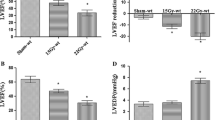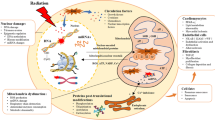Abstract
To explore the expression level and the role of peroxisome proliferator-activated receptor gamma (PPAR-γ) in radiation-induced heart injury in a rat model, thirty-two Sprague–Dawley rats were divided into three groups (the control group, the 15-Gy irradiation group and the 18-Gy irradiation group). Experimental animals were exposed to radiation generated by a linear accelerator at the chest and killed after 3 months. Heart tissues from these animals were removed for Masson staining, PPAR-γ immunohistochemical staining, Western blot analysis and real-time polymerase chain reaction assay (RT-PCR). In addition, the protein expression of matrix metalloprotein-1 (MMP-1), tissue inhibitor of metalloproteinase-1 (TIMP-1) and transforming growth factor type beta1 (TGF-β1), all of which are associated with fibrosis, was measured. Masson staining revealed significant myocardial fibrosis, degeneration and necrosis in rats exposed to radiation. The results of immunohistochemical staining and Western blot analysis showed that PPAR-γ protein expression in hearts of the irradiation groups was significantly higher than in the control group, especially in myocardium and vascular endothelial (p < 0.05). RT-PCR results also showed a parallel increase in PPAR-γ mRNA expression in the heart of the irradiation groups compared with the control group (p < 0.05). The expression of MMP-1 protein was not significantly different in three groups (p > 0.05). The expression of TIMP-1 and TGF-β1 proteins was, however, higher in two irradiation groups than in the control group (p < 0.05). These data demonstrate that PPAR-γ expression is up-regulated on both mRNA and protein levels in heart injured by radiation. PPAR-γ may play an important role in radiation-induced heart injury.







Similar content being viewed by others
References
Adams MJ, Hardenbergh PH, Constine LS (2003) Radiation-associated cardiovascular disease. Crit Rev Oncol Hematol 45:55–75
Akaike A, Kogure T, Oyama K, Oda M (1985) Damage to the heart from tumor irradiation in the thorax—an echocardiographic study. Radiologe 25:430–436
Carr ZA, Land CE, Kleinerman RA, Weinstock RW, Stovall M, Griem ML, Mabuchi K (2005) Coronary heart after radiotherapy for peptic ulcer disease. Int J Radiat Oncol Biol Phys 61:842–850
Chaturvedi RK, Beal MF (2008) PPAR: a therapeutic target in Parkinson’s disease. Neurochem 106:506–518
Chello M, Mastroroberto P, Romano R, Zofrea S, Bevacqua I, Marchese AR (1996) Changes in the proportion of types I and III collagen in the left ventricular wall of patients with post-irradiative pericarditis. Cardiovasc Surg 4:222–226
Chen K, Li D, Zhang X, Hermonat PL, Mehta JL (2004) Anoxia reoxygenation stimulates collagen type-I and MMP-1 expression in cardiac fibroblast s modulation by the PPAR-gamma ligand pioglitazone. J Cardiovasc Pharmacol 44:682–687
Chintalgattu V, Harris GS, Akula SM, Katwa LC (2007) PPAR-γ agonists induce the expression of VEGF and its receptors in cultured cardiac myofibroblasts. Cardiovasc Res 74:140–150
Chomczynski P, Sacchi N (1987) Single-step method of RNA isolation by acid guanidinium thiocyanate-phenol-chloroform extraction. Anal Biochem 162:156–159
Das SK, Chakrabarti R (2006) Role of PPAR in cardiovascular diseases. Recent Pat Cardiovasc Drug Discov 1:193–209
Delerive P, Martin-Nizard F, Chinetti G, Trottein F, Fruchart JC, Najib J, Duriez P, Staels B (1999) Peroxisome proliferator-activated receptor activators inhibit thrombin-induced endothelin-1 production in human vascular endothelial cells by inhibiting the activator protein-1 signaling pathway. Circ Res 85:394–402
Eberhardt W, Akool el-S, Rebhan J, Frank S, Beck KF, Franzen R, Hamada FM, Pfeilschifter J (2002) Inhibition of cytokine-induced matrix metalloproteinase 9 expression by peroxisome proliferator-activated receptor alpha agonists is indirect and due to a NO-mediated reduction of mRNA stability. J Biol Chem 277:33518–33528
Fliegner D, Westermann D, Riad A, Schubert C, Becher E, Fielitz J, Tschöpe C, Regitz-Zagrosek V (2008) Up-regulation of PPAR-γ in myocardial infarction. Eur J Heart Fail 10:30–38
Gosset P, Charbonnier AS, Delerive P, Fontaine J, Staels B, Pestel J, Tonnel AB, Trottein F (2001) Peroxisome proliferator-activated receptor gamma activators affect the maturation of human monocyte-derived dendritic cells. Eur J Immunol 31:2857–2865
Han JY, Kim YJ, Kim L, Choi SJ, Park IS, Kim JM, Chu YC, Cha DR (2010) PPAR-gamma agonist and angiotensin II receptor antagonist ameliorate renal tubulointerstitial fibrosis. J Korean Med Sci 25:35–41
Hancock SL, Tucker MA, Hoppe RT (1993) Factors affecting late mortality from heart disease a after treatment of Hodgkin’s disease. JAMA 270:1949–1955
Hart CM, Roman J, Reddy R, Sime PJ et al (2008) PPAR gamma: a novel molecular target in lung disease. J Investig Med 56:515–517
Issemen I, Green S (1990) Activation of a member of the steroid hormone receptor superfamily by peroxisome proliferators. Nature 347:645–650
Kulkarni AA, Thatcher TH, Olsen KC, Maggirwar SB, Phipps RP, Sime PJ (2011) PPAR-γ ligands repress TGFβ-induced myofibroblast differentiation by targeting the PI3K/Akt pathway: implications for therapy of fibrosis. PLos One 6:e15909
Makino N, Sugano M, Satoh S, Oyama J, Maeda T (2006) Peroxisome proliferator-activated receptor-gamma ligands attenuate brain natriuretic peptide production and affect remodeling in cardiac fibroblasts in reoxygenation after hypoxia. Cell Biochem Biophys 44:65–71
Marx N, Froehlich J, Siam L, Ittner J, Wierse G, Schmidt A, Scharnagl H, Hombach V, Koenig W (2003) Antidiabetic PPAR gamma-activator rosiglitazone reduces MMP-9 serum levels in type 2 diabetic patients with coronary artery disease. Arterioscler Thromb Vasc Biol 23:283–288
Marx N, Duez H, Fruchart JC, Staels B (2004) Peroxisome proliferator-activated receptors and atherogenesis: regulators of gene expression in vascular cells. Circ Res 94:1168–1178
Nellessen U, Zingel M, Hecker H, Bahnsen J, Borschke D (2010) Effects of radiation therapy on myocardial cell integrity and pump function: which role for cardiac biomarkers? Chemotherapy 56:147–152
Pan H, Chen J, Xu J, Chen M, Ma R et al (2009) Antifibrotic effect by activation of peroxisome proliferator-activated receptor-gamma in corneal fibroblasts. Mol Vis 15:2279–2286
Qian L, Cao F, Cui J, Wang Y, Huang Y, Chuai Y, Zaho L, Jiang H, Cai J (2010) The potential cardioprotective effects of hydrogen in irradiated mice. J Radiat Res 51:741–747
Ricote M, Li AC, Willson TM, Kelly CJ, Glass CK (1998) The peroxisome proliferators-activated receptors gamma is a negative regulator of macrophage activation. Nature 391:79–82
Rutqvist LE, Rose C, Cavallin-Stahl E (2003) A systematic overview of radiation therapy effects in breast cancer. Acta Oncol 42:532–545
Schupp M, Kintscher U, Fielitz J, Thomas J, Pregla R, Hetzer R, Unger T, Regitz-Zagrosek V (2006) Cardiac PPAR alpha expression in patients with dilated cardiomyopathy. Eur J Heart Fail 8:290–294
Shiomi T, Tsutsui H, Hayashidani S, Suematsu N, Ikeuchi M, Wen J, Ishibashi M, Kubota T, Egashira K, Takeshita A (2002) Pioglitazone a peroxisome proliferator-activated receptor-gamma agonist attenuates left ventricular remodeling and failure after experimental myocardial infarction. Circulation 106:3126–3132
Shi-wen X, Eastwood M, Stratton RJ, Denton CP, Leask A, Abraham DJ (2010) Rosiglitazone alleviates the persistent fibrotic phenotype of lesional skin scleroderma fibroblasts. Rheumatology (Oxford) 49:259–263
Sporn MB, Roberts AB (1989) Transforming growth factor-β. Multiple actions and potential clinical applications. JAMA 262(7):938–941
Tyagi SC, Kumar S, Voelker DJ, Reddy HK, Janicki JS, Curtis JJ (1996) Differential gene expression of extracellular matrix components in dilated cardiomyopathy. J Cell Biochem 63:185–198
Wu R, Zeng Y (2009) Does angiotensin II-aldosterone have a role in radiation-induced heart disease? Med Hypotheses 72:263–266
Acknowledgments
This work was supported in part by the Department of Clinical Oncology and Central Laboratory of Shengjing Hospital of China Medical University. We thank for the guidance of Professor Zhengwei Yuan and also thank Fuda Xiao and Jianing Miao for excellent technical assistance.
Author information
Authors and Affiliations
Corresponding author
Rights and permissions
About this article
Cite this article
Gao, S., Wu, R. & Zeng, Y. Up-regulation of peroxisome proliferator-activated receptor gamma in radiation-induced heart injury in rats. Radiat Environ Biophys 51, 53–59 (2012). https://doi.org/10.1007/s00411-011-0390-9
Received:
Accepted:
Published:
Issue Date:
DOI: https://doi.org/10.1007/s00411-011-0390-9




